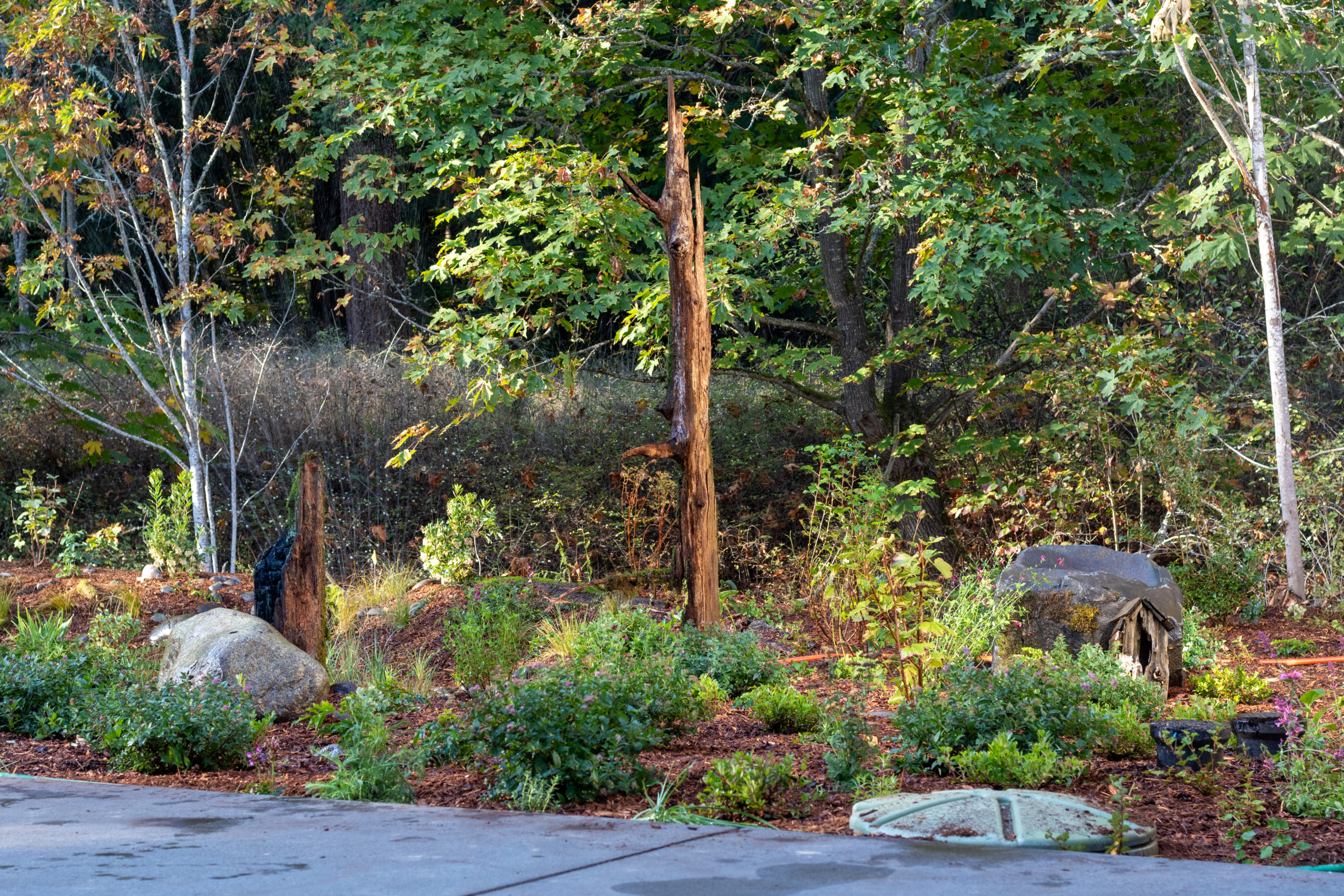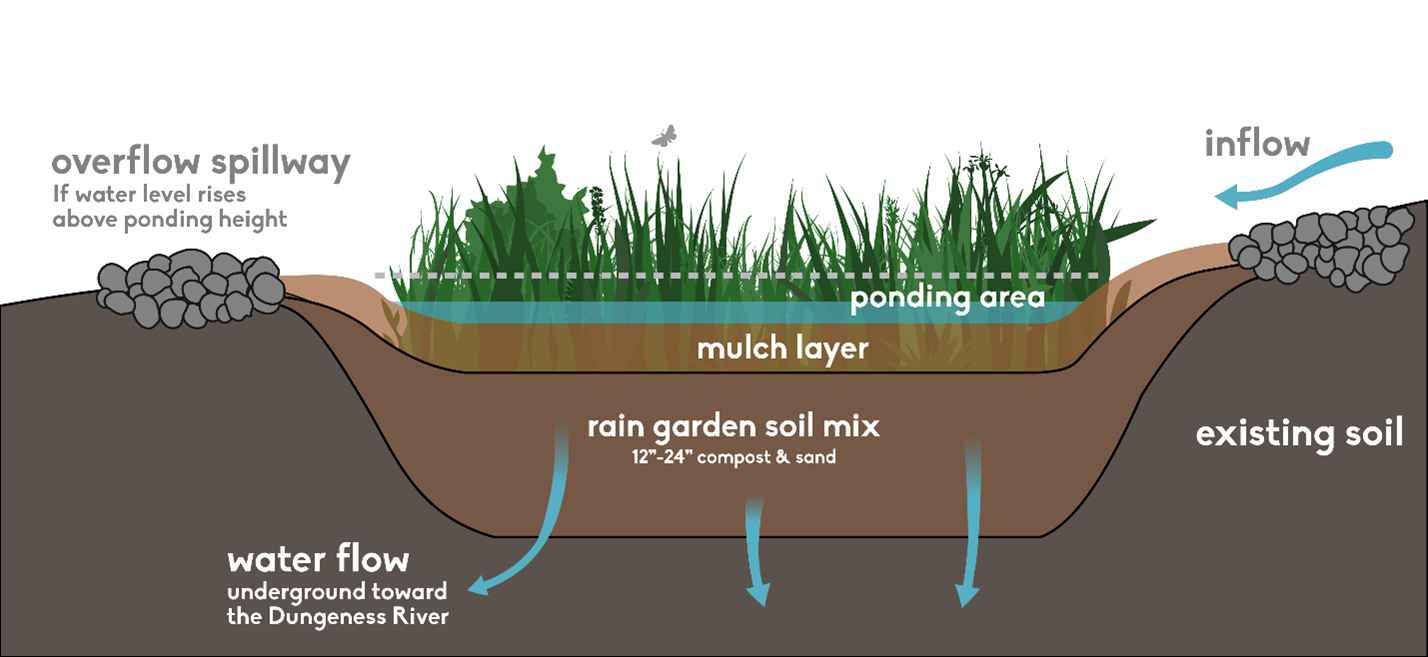Rain Garden

What is a Rain Garden?
A rain garden is a beautiful and effective way to manage stormwater runoff. Each time it rains, water runs off hard surface such as pavement, roofs and walkways, collecting pollutants along the way. Rain gardens capture that water and allow it to soak into the ground, preventing flooding and recharging groundwater.
The compost-rich soil and vegetation filters out contaminates, while providing food and habitat for beneficial birds and insects. The plants are specially selected for their ability to tolerate very dry conditions or being completely inundated. A mulch layer reduces weeds and locks in moisture.
How do Rain Gardens Work?
Rather than rushing into the river, rainwater from the roofs and walkway flows into the garden where it slows down and soaks into a mix of sand and compost. The plants gradually absorb and filter stormwater. The clean water then slowly flows underground to the Dungeness River. This large garden receives about 40,000 gallons from 5,000 square feet of hard surfaces.

The Story of our Rain Garden
When the Dungeness River Nature Center decided to expand our building from 1,600 sq. ft. to more than 7,000, we realized that we would be adding more impermeable surfaces which could result in increased runoff to the river. When looking for a way to treat stormwater running off the new roofs and hard surfaces, a rain garden seemed like the perfect solution to protect the nearby Dungeness River.
Fortunately, WSU Extension had a grant to build a demonstration rain garden and they selected our site! A planning team was formed made up of representatives from the Center, Jamestown S’Klallam Tribe, and WSU staff. Together we determined the goals for the garden:
- Building a functional rain garden to treat stormwater runoff
- Providing an opportunity to educate visitors and encourage them to build a rain garden at home
- Creating habitat for wildlife including pollinators.
WSU provided the design expertise and funding and support for the planting. The Tribe excavated the site and provided the rain garden soil mix and mulch. The Center helped recruit and organize the volunteers and will be responsible for maintaining the garden.
Planning
The first step was assessing the site and determining which areas will drain into the rain garden. The best location for the rain garden was the westside of the building. This area was used as a construction equipment staging site during construction and was going to be transformed into a beautiful rain garden. When it rains, water that hits the roof will be captured in gutters and directed into downspouts that flow to the rain garden in underground pipes. The rain that flows off the surrounding paved surfaces will also be captured.
To design the rain garden, we followed the steps in the Rain Garden Handbook for Western Washington and:
- Determined the “contributing area” that would drain to the rain garden
tested the soil - Dug a perk hole to test the infiltration at the site
- Determined the ponding depth and size of the garden
- Developed a design for the rain garden shape and size
- Located the inflows and overflow location
- Confirmed the plan with the planning team

Building
The rocky soil of the site was excavated by the Tribe in October 2022 to a depth of about three feet. The bottom of the rain garden was leveled out. A mix of soil and compost was added to the site to a depth of 18 inches – until the inflow pipes were level with the bottom of the rain garden. A rock-lined overflow was constructed in case the water overflows.
Planting and Mulching
A variety of small trees, shrubs, groundcovers, and grasses that would be suitable for the sunny location were chosen for the planting zones in the rain garden. The bottom of the rain garden is the infiltration zone – where the stormwater soaks in. These plants need to be able to withstand being underwater for short periods and also tolerate drought. The plants along the sides must be able to tolerant occasional standing water. The area surrounding the rain garden are more drought tolerant.
With the help of a team of 50 volunteers, we were able to fill the space with these special plants. They placed layer mulch three to four inches deep to reduce weeds and prevent erosion. Watch the volunteers in action on this time-lapse video.

Maintenance
Rain gardens, like any garden need maintenance to perform. Volunteers will provide water for the first few years to establish plants, and check to make sure the inlets and overflow is clear of debris.
If you would like to be one of the volunteers who helps to keep our rain gardening functioning, please contact Volunteer Coordinator, Linda Gonzales

Consider a Rain Garden at Your Home
You too can help reduce water pollution and prevent flooding. Rain gardens can be built in all shapes and sizes, making them a great addition to any yard!
If you would like to know more about how to get started, check out these resources!
- Puget Sound Rain Gardens – overview of rain gardens, WSU Extension resources, and information on assessing and maintaining your rain garden.
- Rain Garden Basics – a brief introduction to the components of a rain garden.
- 12000 Rain Gardens – In-depth information about rain gardens, resource library, events, and rain garden registry.
- Rain Garden Handbook for Western Washington – a guide to design, installation and maintenance of rain gardens in western Washington.
- Rain Garden Training Course – Online, self-paced course offered by Washington State University Extension and the Washington Stormwater Center. The training course is designed for property owners and LID enthusiasts interested building a rain garden.
- Video: Building a Rain Garden in the Pacific Northwest – A 32 minute video detailing how to build a rain garden.
- WSU Rural Stormwater Solutions – Learn more about this rain garden and see photos of each step.


